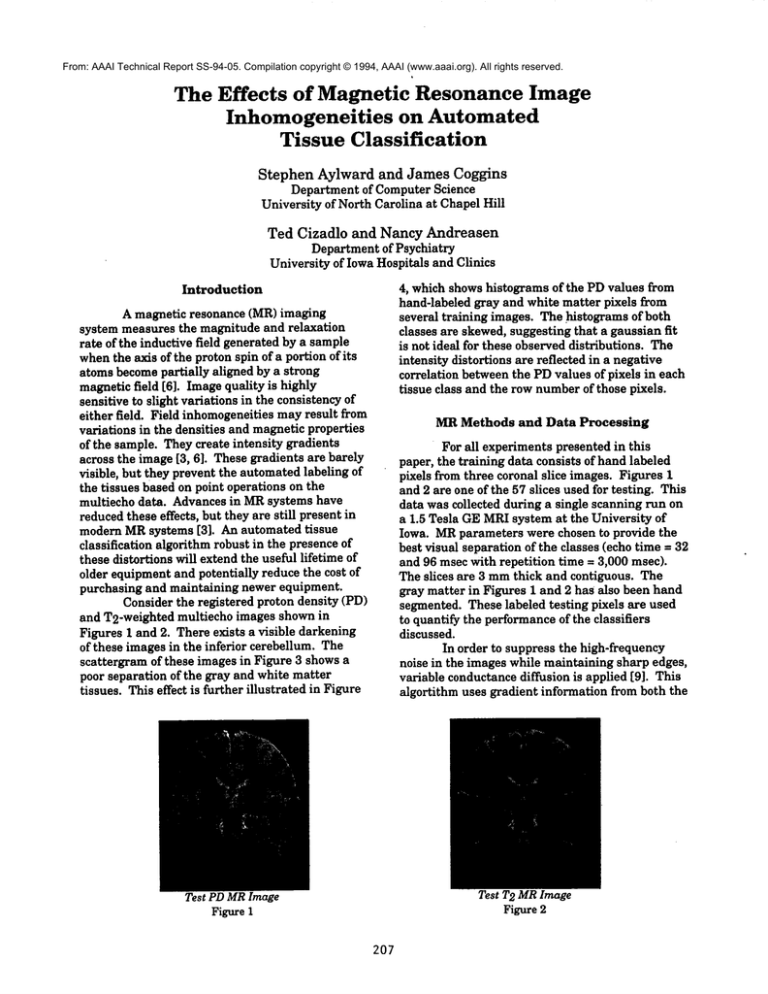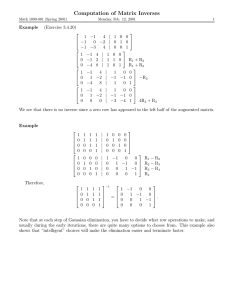
From: AAAI Technical Report SS-94-05. Compilation copyright © 1994, AAAI (www.aaai.org). All rights reserved.
The Effects of Magnetic Resonance Image
Inhomogeneities
on Automated
Tissue Classification
Stephen
Aylward and James Coggins
Department of Computer Science
University of North Carolina at Chapel Hill
Ted Cizadlo and Nancy Andreasen
Department
of Psychiatry
University
of IowaHospitals
andClinics
Introduction
A magneticresonance(MR) imaging
systemmeasuresthe magnitude
and relaxation
rateof theinductive
fieldgenerated
by a sample
whentheaxisof theproton
spinof a portion
of its
atomsbecomepartially
aligned
by a strong
magnetic
field[6].Imagequality
is highly
sensitive
to slight
variations
in theconsistency
of
eitherfield.Fieldinhomogeneities
mayresultfrom
variations
in thedensities
andmagnetic
properties
of thesample.
Theycreateintensity
gradients
acrosstheimage[3,6].Thesegradients
arebarely
visible,
buttheyprevent
theautomated
labeling
of
thetissues
basedon pointoperations
on the
multiechodata.Advancesin MR systemshave
reduced
theseeffects,
buttheyarestillpresent
in
modernMR systems[3]. An automatedtissue
classification
algorithm
robust
in thepresence
of
thesedistortions
willextend
theuseful
lifetime
of
olderequipment
andpotentially
reducethecostof
purchasing
and maintaining
newerequipment.
Consider
theregistered
protondensity
(PD)
and T2-weighted
multiecho
imagesshownin
Figures
I and2. Thereexistsa visible
darkening
of theseimagesin theinferior
cerebellum.
The
scattergram
of theseimagesin Figure3 showsa
poorseparation
of thegrayandwhitematter
tissues.
Thiseffect
is further
illustrated
in Figure
4, which shows histograms of the PD values from
hand-labeled gray and white matter pixels from
several training images. The histograms of both
classes are skewed, suggesting that a gaussian fit
is not ideal for these observed distributions. The
intensity distortions are reflected in a negative
correlation between the PDvalues of pixels in each
tissue class and the row number of those pixels.
MR Methods and Data Processing
Forallexperiments
presented
in this
paper,thetraining
dataconsists
of handlabeled
pixelsfromthreecoronal
sliceimages.
Figures
1
and2 areoneof the57 slices
usedfortesting.
This
datawascollected
duringa singlescanning
runon
a 1.5 TeslaGE MRI systemat the University
of
Iowa.MR parameters
werechosento providethe
bestvisualseparation
of theclasses
(echotime= 32
and96 msecwithrepetition
time= 3,000msec).
Theslicesare3 mm thickand contiguous.
The
graymatterin FiguresI and2 has alsobeenhand
segmented.
Theselabeledtesting
pixelsare used
to quantify
theperformance
of theclassifiers
discussed.
In orderto suppress
thehigh-frequency
noisein the imageswhilemaintaining
sharpedges,
variable
conductance
diffusion
is applied
[9].This
algortithm
usesgradient
information
fromboththe
Test T2 MR Image
Figure 2
Test PD MRImage
Figure 1
207
255"
SO0~
¯
II
I ¯ GreyMatter
]
la te
g
.’,
0
0
!
!
!
.
~"
’
-’
-"
"
:
""
:
PDValue
Scattergramof FiguresI and 2
Figure3
-"
-"
255
100
PD Value
200
Histogramsof Grayand White
Matter PDValues in Training Data
Figure 4
PDand T2 imagesto control the diffusion process.
Twentyiterations were run with conductance = 3
and o = 0.6 so that small imagestructures are
preserved. The end result is an improvementin
the separation and variance oftbe tissue classes in
feature space. This process provides only minimal
compensationfor the intensity distortion.
Two Dimensional Feature Space
The PDand T2 values at each pixel provide
the coordinates of that pixel in the two dimensional
feature space commonlyused by MRclassification
methods(Figure3) [1, 3, 4, 5, 6, 8].
To label pixels in test images,a gaussian
density can be fitted to the observeddistribution of
pixels in each class. A maximum
likelihood
estimator can then be developedusing the fitted
densities. This is the most commonprocess for MR
pixel labeling[1, 3, 4, 5, 6].
Feature space is optimized by computing
"1.
eigenvectors of the Hotelling matrix, H = Sb Sw
This matrix is a multivariate signal-to-noise ratio
that has been shownto correlate with
discrimination in humanperception. Eigenvectors
of this matrix define a newbasis for the feature
space based on howwell the features separate the
classes defined by the training data. The
minimumMahalanobis distance of test pixels from
the class-conditional densities provides the
maximum
likelihood assignment of pixels to
classes[2, 4, 9].
Classification of Figures I and 2 using a
gaussian classifier based on the optimized basis
defined by the eigenvectors of the Hotelling matrix
yields the labeling shownin Figure 5. Whilethe
classification is accurate in the upper portion of the
image, poor labeling occurs in the lower part. This
classifier misclassified 29.1%of the hand labeled
gray matter test pixels.
Augmenting Feature Space
A mapof the intensity distortion is
obtained by calculating the meanof the gray
matter class as a function of the row and column
number. Figure 6 shows the map generated from
the training data. The correlation visible in the
figure suggests that improvedclassification might
result if the row numberand perhaps also the
columnnumber are added as features.
Using the four dimensional feature space
(PD, T2, row, and column)a gaussian classifier
does yield improvedresults (Figure 7). Gray
matter misclassification is reduced to 16.8%.
However,overlaying the approximated class
Mapof the Intensity
Deformations
Affecting Classification
Figure 6
GaussianClassification
UsingPDand T2 Values
Figure5
208
255’
RowNumber
0
255
Location of Classes in RowVersus PD
Feature Space with T2 = 175
Figure 8
GaussianClassification
Using PD,7"2, Row, and
Column Information
Figure 7
using a gaussian mixture model. The classifier uses
multiple gaussians to represent each class. For
this study, the training data for each class was
manually separated into two subclasses using a
hyperplane at the point of highest curvature in the
feature space. This point corresponds roughly with
the top of the cerebellum, row number 175.
The resulting eight class classifier (gray
matter below row 175, gray matter at or above row
distributions onto the distribution of the PDvalues
for the hand labeled gray matter test pixels
indicates that a single gaussian does not capture
all of the deformation (Figure 8).
Improving the Classifier
A more accurate model of the distribution
of the classes in feature space can be obtained by
o 100
o 100
PDValue
200
Histogramof PDValues for Gray and
White Matter for Training Subclass
with Row <175
Figure 9
PDValue
200
Histogramof PDValues for Gray and
White Matter for Training Subclass
with Row> =175
Figure 10
255’
0
RowNumber
255
Location of Classes in RowVersus PD
Feature Space with T2 = 175
Figure 12
Subclass GaussianClassifier Results
Figure 11
209
Current work is focusing on implementing
an automated mixture model clustering algorithm.
This should both simplify and improve the
accuracy of the MRclassification process.
Additional work is being performed on the 3D
visualization tool and on the multimodal variable
conductance diffusion algorithm.
175, etc.) was created by treating each subclass as
a unique class and then applying standard
gaussian classification techniques. This produced
a much more accurate system.
Figures 9 and 10 show how the partitioning
of the training data isolates the skewness to just
one of the subclasses. Notice the reduction in class
overlap and the increase in distance between the
means when compared with Figure 4. Figure 11
shows the accurate labeling of the test data in both
the upper and lower portions of the image. Gray
matter misclassification is reduced to 7.4%. Figure
12 depicts the modeling of the classes in feature
space which is achieved using this technique.
Fromthe labeling of the 57 test slices it is
possible to reconstruct the 3D structure of the
sample being imaged. Figure 13 shows one view of
this data as displayed by a real-time 3D volume
visualization tool which is under development at
the Department of Radiology in the School of
Medicine at the University of North Carolina.
We wouldliketo thankTerryYoo,Mike
Northand GrahamGash from UNC for their
assistance
withthisproject.
We wouldalsoliketo
thankVictorSwayzefromthe VeteransAffair
Medical
Centerin IowaCityforhisinsight
intothe
issues
of MRtissue
classification.
References
[1] Cohen, G. et al, "Segmentation Techniques for
the Classification of Brain Tissue Using
Magnetic Resonance Imaging", Psychiatry
Research: Neuroimaging, Elsevier, Vol. 45,
1992. pp. 33-51
[2] Duda, R. and Hart, P., Pattern Classification
~nd Scene Analysis, John Wiley and Sons,
1973
[3] Gerig, G. et al, "Automating Segmentation of
Dual-Echo MRHead Data" Information
Processing in Medical Imaging, SpringerVerlag, 1991
[4] Hanson, K., "Introduction to Bayesian Image
Analysis ~, SPIE Medical Imaging, Vol. 1898,
1993
[5] Kubler, O. and Gerig G., "Segmentation and
Analysis of Multidimensional Data-Sets in
Medicine~, 3D Imaging in Medicine,
Springer-Verlag, 1990
Real-Time Volume Rendering
of the 31) Structure Reconstructed
fromthe Classified Slices
Figure 13
[6] Loeffler, W., "Magnetic Resonance Imaging", 3D
Imaging in Medicine, Springer-Verlag, 1990
[7] McLachlan, G. and Basford, K., Mixture
Models: Inference and Anplications to
~, Marcel
Dekker,
INC. 1988
Conclusion
Inhomogeneities in the generated and
induced fields of MRsystems produce nonlinear
intensity distortions in the resulting MRimage
data. An analysis of feature space clearly shows
that these inhomogeneities reduce classification
accuracy when standard classifiers
and feature
spaces are used. Improved labeling of tissues in
MRimages can be achieved by augmenting feature
space with spatial information and increasing the
class representation capabilities of the classifier
using mixture modeling techniques.
[8] Vandermeulen, D. et al., "Continuous Voxel
Classification by Stochastic Relaxation:
Theory and Application to MRImaging and
MRAngiographf’ Information Processing in
Medical Imaging, Springer-Verlag, 1993
[9] Yoo, T. and Coggins, J., "Using Statistical
Pattern Recognition Techniques to Control
~,
Variable Conductance Diffusion
Information Processing in Medical Imaging,
Springer-Verlag, 1993
210

